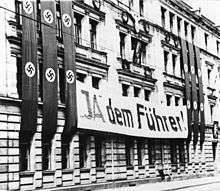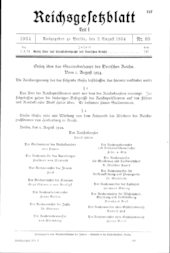German referendum, 1934

A referendum on merging the posts of Chancellor and President was held in Germany on 19 August 1934,[1] after the death of President Paul von Hindenburg seventeen days earlier. The German leadership sought to gain approval for Adolf Hitler's assumption of supreme power. The referendum was associated with widespread intimidation of voters, and Hitler used the resultant large "yes" vote to claim public support for his activities as the de facto head of state of Germany. In fact, he had assumed these offices and powers immediately (and illegally) upon von Hindenburg's death and used the referendum to legitimize this move, taking the title Führer und Reichskanzler (Führer and Chancellor).
Background
When President Hindenburg dictated his testament in May, he included as his "last wish" that the Hohenzollern monarchy would be restored by Hitler. His son, Oskar von Hindenburg, passed the testament on to Vice Chancellor Franz von Papen, who in turn gave it to Hitler on 14 August. The next day, 15 August, Hitler had it published, without any indication of Hindenburg's "last wish".[2]
On 1 August, with Hindenburg's death imminent, the Reichstag had passed the Law on the Head of State of the German Reich, merging the offices of head of state (president) and head of government (chancellor). Immediately after Hindenburg's death on 2 August, the commander-in-chief of the armed forces, Werner von Blomberg, ordered all members of the Wehrmacht (armed forces) to take an oath to the Führer.[2]
Conduct of the referendum

The wording of the referendum question was:
- The office of the President of the Reich is unified with the office of the Chancellor. Consequently all former powers of the President of the Reich are demised to the Führer and Chancellor of the Reich Adolf Hitler. He himself nominates his substitute.
- Do you, German man and German woman, approve of this regulation provided by this Law?[3]
The government used widespread intimidation and electoral fraud to secure a large "yes" vote. This included stationing brownshirts at polling stations and forcing clubs and societies to march to polling stations escorted by Nazi storm troopers and then vote in public. In some place polling booths were removed or banners reading "only traitors enter here" hung over the entrances to discourage secret voting. In addition, many ballot papers were pre-marked with "yes" votes, spoiled ballot papers were frequently counted as having been "yes" votes, and many "no" votes were recorded to have been in favour of the referendum question. The extent of this forgery meant that in some areas the number of votes recorded to have been cast was greater than the number of people able to vote.[4]
The relative lack of support in Hamburg in 1933 had prompted Hitler to declare a national holiday on 17 August 1934 so that he could address the German people directly over the 4.3 million registered radio sets.[5]
Results
Support for merging the offices of president and chancellor was greatest in East Prussia, where official figures show that 96% voted in favour.[5] Support was lowest in urban districts. It was weakest of all in Hamburg, where just under 80% voted affirmatively (20.4% against). In Aachen, 18.6% voted against. In Berlin, 18.5% of votes were negative and every district reported negative vote share greater than 10%. In the former communist stronghold of Wedding it was 19.7% against.[5] The extent of the intimidation influenced the size of the "yes" vote.[4] Overall support for the government was lower than in the referendum of 12 November 1933. Where the referendum of 1933 had received support from 89.9% of the total electorate, that of 1934 had only 84.3% support.[2] The regional variation, however, was identical to that in the referendum of 1933.[5]
The Nazi leadership were disappointed by the results of the referendum.[6] For instance, Joseph Goebbels' diary entry for 22 August speaks of the referendum as a failure: "Initial results: very bad. Then better. Finally over 38 million for the Führer. I expected more. The Catholics failed Rosenberg!"[7] Nevertheless, historian Ian Kershaw has judged that even after accounting for the manipulation of the voting process, the results "reflected the fact that Hitler had the backing, much of it fervently enthusiastic, of the great majority of the German people" at the time.[6]
| Choice | Votes | % |
|---|---|---|
| For | 38,394,848 | 88.1 |
| Against | 4,300,370 | 9.9 |
| Invalid/blank votes | 873,668 | 2.0 |
| Total | 43,568,886 | 100 |
| Registered voters/turnout | 45,552,059 | 95.7 |
| Source: Nohlen & Stöver | ||
References
- ↑ D. Nohlen and P. Stöver (2010), Elections in Europe: A Data Handbook, p. 762, ISBN 978-3-8329-5609-7.
- 1 2 3 H. A. Winkler (2006), Germany: The Long Road West, Volume II (1933–1990) (Oxford University Press), pp. 38–39.
- ↑ Min Shu (27 May 2014), "Consolidating Leadership: Referendums in Nazi Germany and Postwar France", lecture notes for Introduction to Direct Democracy (Waseda University), p. 4
- 1 2 Richard J. Evans (2006). The Third Reich in Power 1933–1939. London: Penguin. p. 110. ISBN 9780141009766.
- 1 2 3 4 Arnold J. Zurcher (1935). "The Hitler Referenda". American Political Science Review. 29 (1): 91–99. doi:10.2307/1947171.
- 1 2 Ian Kershaw (1998). Hitler, 1889–1936: Hubris. London: Penguin. p. 526. ISBN 9780140133639.
- ↑ Markus Urban (2011), "The Self-Staging of a Plebiscitary Dictatorship: The NS-Regime Between 'Uniformed Reichstag', Referendum and Reichsparteitag", in Ralph Jessen; Hedwig Richter, Voting for Hitler and Stalin: Elections Under 20th Century Dictatorships, New York: Campus Verlag, p. 43n